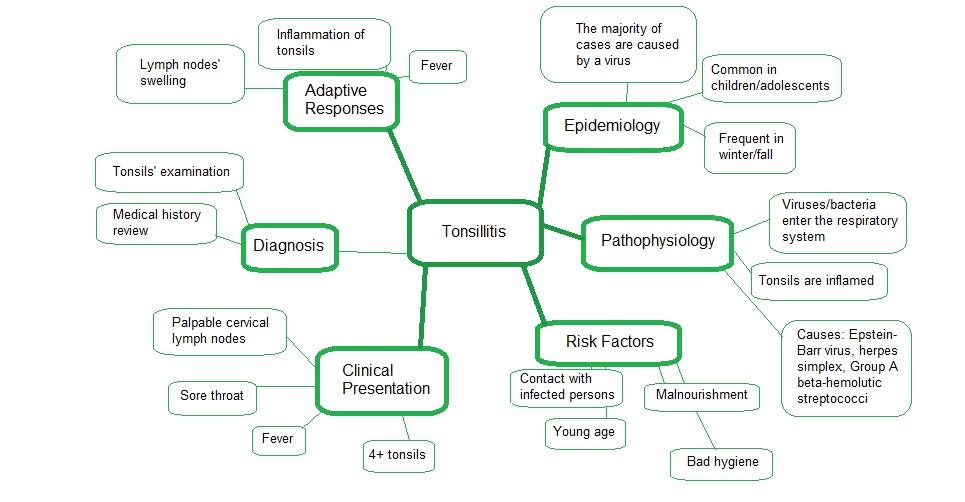Introduction
While diagnosing patients, nurses should remember to interpret the body’s responses and visual cues to consider all compensatory mechanisms that it engages. In the following scenarios, all patients have alterations in their health that show how symptoms reveal an underlying cause for their condition. The body’s line of defense often includes inflammation – a response to the tissue being damaged, directed at preventing further harm (Huether & McCance, 2017). In the first presented problem, the patient’s throat is reddened, and she has enlarged tonsils, thus allowing one to see which areas of the body are affected. In the second case, the man has a topical response of red and dry skin on his hands. Finally, the third situation shows a woman with lowered food and sleep needs. In the first scenario, the patient can be diagnosed with tonsillitis, the second situation involves a man with allergic contact dermatitis, and the final case describes a woman with sleep disturbances induced by stress.
Scenario 1
The 2-year-old female patient presents a variety of symptoms that can be linked to tonsillitis. This is an infectious disease characterized by the inflammation of tonsils (Bartlett, Bola, & Williams, 2015). Other symptoms may include fever, difficulty swallowing, sore throat, clearly palpable lymph nodes (usually anterior cervical nodes), and enlarged tonsils (Bartlett et al., 2015). The onset of acute tonsillitis can be rapid, and this disease is often present in young people – children and adolescents. Furthermore, fall and winter seasons have more cases of tonsillitis and similar infections than others (Bartlett et al., 2015). All of the symptoms mentioned above can be clearly perceived in the discussed patient. This disease is among those conditions that are viral in origin – people exposed to bacteria or viruses may transfer this infection to others. Bacterial organisms enter the respiratory tracks and cause an inflammatory response in tonsils, where white blood cells initiate an immune reaction to destroy the harmful bacteria. This process causes fever and the enlargement of the tonsils, as the body tries to adjust to the healing process.
Scenario 2
The man’s recent use of chemicals without gloves led to him developing allergic contact dermatitis. This condition is characterized by a topical response of the skin to some substances – abrasive solvents, creams, liquids, and other allergens. Its symptoms include rashes and patches of irritates skin, especially in areas that came into contact with the allergen. Moreover, the reaction of this type does not happen instantly but develops over the course of multiple days (Kostner et al., 2017). The patient’s symptoms indicate that his skin became red and dry after some time of using chemicals without gloves. It is possible that while he worked with these substances before, his protective gear lowered the contact with the body and prevented it from having an allergic reaction. However, repeated contact with chemicals increased sensitization and activated the delayed hypersensitivity response (Kostner et al., 2017).
Scenario 3
In the third case, the woman’s symptoms are not as visual as those in the previous situations. Nevertheless, they also represent the reaction of the immune system. The woman’s lack of sleep and appetite, as well as her increased heart rate, signify a condition known as a stress response. According to Gouin et al. (2015), worry periods (such as the patient’s need to care for her mother) are often followed by increased sleep disturbances and high-frequency heart rate. As the woman comes under mental pressure, she experiences mental and physiological arousal which is manifested in an increased heart rate and an overall heightened activity of the body. It is possible that hypertension also contributes to this condition, although the woman takes appropriate medications. Overall, disturbance of sleep patterns and lack of appetite are among the most prevalent body responses to stress (Gouin et al., 2015).
Conclusion
Three scenarios have the following diagnoses: tonsillitis, allergic contact dermatitis, and stress-induced sleep disturbance. The symptoms perceived in all cases can be explained by the body’s immune system activating to heal damaged tissue and stop the spreading of disease. For example, inflammation is a common second-line reaction to viruses entering and destroying healthy cells. In the first scenario, the patient’s tonsils are red and enlarged because the immune system responded to the presence of bacteria or viruses in this area and focused its’ production of active cells for this region. Similarly, the second example reveals how the system tries to protect certain parts of the body from reacting to the allergen. These responses of the body to show how it reacts to irritants and infections and adapts its functioning to mitigate the problem or encourage healing.
Mind Map for Tonsillitis

References
Bartlett, A., Bola, S., & Williams, R. (2015). Acute tonsillitis and its complications: An overview. Journal of the Royal Naval Medical Service, 101(1), 69-73.
Gouin, J. P., Wenzel, K., Boucetta, S., O’Byrne, J., Salimi, A., & Dang-Vu, T. T. (2015). High-frequency heart rate variability during worry predicts stress-related increases in sleep disturbances. Sleep Medicine, 16(5), 659-664.
Huether, S. E., & McCance, K. L. (2017). Understanding pathophysiology (6th ed.). St. Louis, MO: Mosby.
Kostner, L., Anzengruber, F., Guillod, C., Recher, M., Schmid-Grendelmeier, P., & Navarini, A. A. (2017). Allergic contact dermatitis. Immunology and Allergy Clinics, 37(1), 141-152.